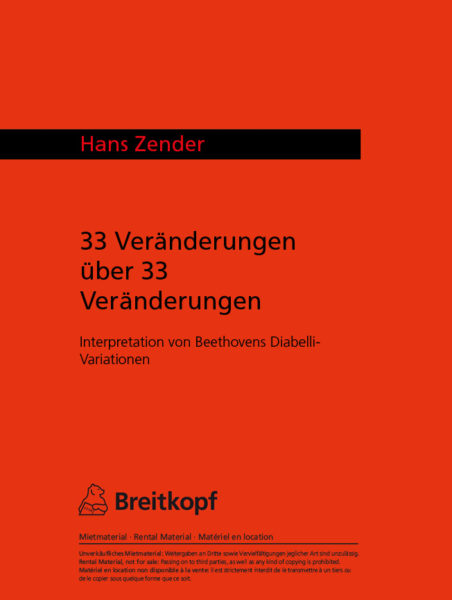Hans Zender (1936–2019) 33 Veränderungen über 33 Veränderungen
Neufassung 2019 – Eine komponierte Interpretation der Diabelli-Variationen von Beethoven [Ens] 2010/11/19 Dauer: 57'
2Fl(Picc.A-Fl).2Ob(Eh).2Klar.2Fg(Kfg) – 2Hn.2Trp.Pos.Tuba – 4Schl – Hfe – Klav.Akk – 2Vl.Va.Vc.Kb (oder chorisch)
Uraufführung: Berlin, 9. November 2011
Uraufführung der Neufassung (Ensemblefassung): Wien, 26. Oktober 2019
Uraufführung der Neufassung (Orchesterfassung): München, 22. November 2019
Meine Interpretation von Schuberts Winterreise ist teilweise missverstanden worden. Auf der einen Seite entstand die Vorstellung, eine solche Bearbeitung müsse nostalgisch sein, auf der anderen Seite wurde das Werk von einigen Traditionalisten als Brechung des Originals verstanden. Das stimmt beides nicht, denn es bewegt sich einer Mittellinie zwischen diesen Möglichkeiten. ... Es hat mich gereizt, nochmals diesen Balanceakt zu probieren. Nietzsche hat etwa gesagt: Das Verhältnis von Altem zu Neuem ist immer so, dass das Neue das Alte destruiert. Es gibt nur eine Möglichkeit, dies zu vermeiden und das ist ein „furchtloses Schweben“ über dem Abgrund der Geschichte. Dieses Schweben zwischen den uns vertrauten Stilen ist ein eigener Reiz, der nicht nur beim Komponisten, sondern auch beim Hörer neue Erfahrungen auslösen kann.
(Hans Zender)
Ein Gespräch mit Hans Zender
Mit Hans Zender, der in diesem Jahr seinen 75. Geburtstag feiert, verbindet das Ensemble Modern von Beginn an eine enge Zusammenarbeit. In den späten 1970er Jahren leitete Hans Zender die Junge Deutsche Philharmonie und gab maßgebliche Impulse zur Gründung des Ensemble Modern, 1993 initiierte er die Gesprächskonzert-Reihe „Happy New Ears“. Im selben Jahr fand die Uraufführung seiner komponierten Interpretation von Schuberts Winterreise durch das Ensemble Modern statt. Das Ändern, Bearbeiten und Reagieren auf bereits existierende Werke der Vergangenheit stellt einen der vielen kompositorischen Ansätze Hans Zenders dar. Zu seinen bisherigen Anknüpfungspunkten zählen Joseph Haydn, Franz Schubert, Robert Schumann und Claude Debussy. Nun widmet sich Hans Zender in seinem neuen Werk 33 Veränderungen über 33 Veränderungen Ludwig van Beethovens Diabelli-Variationen. Roland Diry (RD) sprach mit Hans Zender (HZ) über die Auseinandersetzung mit Beethovens letztem großen Klavierwerk und umfangreichstem Variationenzyklus.
RD: Im August letzten Jahres hast du mir bei unserem Treffen gesagt, dass du schon früher die Idee hattest, die Diabelli-Variationen zu „bearbeiten“. Dabei bist du davon ausgegangen, nicht für Orchester, sondern für Ensemble zu schreiben. Wie bist du an das Werk herangegangen und wie lief die Auseinandersetzung ab?
HZ: Ich glaube, es gibt noch mehr Komponisten, die damit geliebäugelt haben, dieses ungewöhnliche Werk in irgendeiner Weise zu instrumentieren oder weiterzuentwickeln. Ich habe mich mein Leben lang nicht getraut, denn auf der einen Seite bietet sich das Stück dafür an, auf der anderen Seite ist es bereits in einem derartigen Grad modern, dass man sich fragt: Was kann man hier noch „moderner“ formulieren? Ich habe dann doch über das Projekt nach-gedacht und zwar nur wegen der hartnäckigen Nachfragen des Ensemble Modern. Ich hatte eine große Hemmschwelle zu überwinden, doch dann habe ich angefangen, die Arbeit hat mir sofort sehr viel Spaß gemacht und plötzlich waren ein paar Variationen fertig
RD: Und wo war die spezielle Hürde, die du überwinden musstest?
HZ: Es ist natürlich die Grundfrage einer jeden komponierten Interpretation: Wie bewege ich mich auf sinnvolle Weise zwischen einer möglichst großen Nähe zum Original und einer völligen Neuformulierung. Hierbei gibt es viele Möglichkeiten zu verunglücken. Man kann ein Original „vergewaltigen“, es zerstören bei solchen Bearbeitungen, man kann aber auch zu sehr im Bann des Originals bleiben, so dass sich nichts wirklich substantiell Neues entwickelt. Es ist eine Balance, die man zwischen den beiden Polen einer Interpretation bewältigen muss: der eigenen Autorschaft und dem Wiedererscheinen eines großen alten Werks. Man versucht dem Text gerecht zu werden und gleichzeitig die eigene Individualität einzubringen. Meine Interpretation von Schuberts Winterreise ist teilweise missverstanden worden. Auf der einen Seite entstand die Vorstellung, eine solche Bearbeitung müsse nostalgisch sein und auf das Original zurückweisen, auf der anderen Seite wurde das Werk von einigen Traditionalisten als eine Zerstörung oder Brechung des Originals verstanden. Das stimmt beides nicht, denn es bewegt sich genau auf einer Mittellinie zwischen diesen beiden Möglichkeiten. Die Herausforderung bei Beethovens Diabelli-Variationen ist mindestens so groß wie bei Schubert.
RD: Was war denn das Besondere an dem Beethovenschen Werk, das dich gereizt hat, diese Auseinandersetzung trotzdem einzugehen?
HZ: Ganz aufzuklären ist das glaube ich nicht, denn etwas Irrationales ist immer dabei. Es hat mich gereizt, nochmals diesen Balanceakt zu probieren. Nietzsche hat etwa gesagt: Das Verhältnis von Altem zu Neuem ist immer so, dass das Neue das Alte destruiert. Es gibt nur eine Möglichkeit, dies zu vermeiden und das ist ein „furchtloses Schweben“ über dem Abgrund der Geschichte. Dieses „Schweben“ zwischen den uns vertrauten Stilen ist ein eigener Reiz, der nicht nur beim Komponisten, sondern auch beim Hörer neue Erfahrungen auslösen kann.
RD: Wie bist du den Diabelli-Variationen nahe gekommen?
HZ: Ich habe mich sehr intensiv mit dem Werk beschäftigt, indem ich über lange Zeit pianistisch daran gearbeitet habe. Ich habe vieles entdeckt, das mein Beethoven-Bild komplementiert und verändert hat. Mich hat besonders verblüfft, dass Beethoven in diesem Stück schon „die Frage nach dem Autor“ stellt. Als Beethoven die Diabelli-Variationen schrieb, hatte er schon ein riesiges Gesamtwerk vorgelegt und eine ganze Epoche formuliert, nämlich die des Subjektivismus. In diesem Spätwerk scheint Beethoven den Subjektivismus nicht nur zu erfüllen, sondern er überschreitet ihn, indem er in diesen 33 Veränderungen 33 Welten und nicht eine einheitliche Welt konstruiert. Es gibt die vielfältigsten Reminiszenzen an den Barock und Vorausblicke auf die Romantik. Es ist ein Jonglieren am Abgrund des Zerbrechens des Ganzen. Das komponierende Ich entdeckt, dass es selbst eine Vielheit und keine Einheit ist. Damit realisiert Beethoven schon Anfang des 19. Jahrhunderts eine Problematik in Tönen, die eigentlich erst zum 20. Jahrhundert gehört, z.B. in der Literatur bei James Joyce oder Luigi Pirandello. Es ist eine moderne Problemstellung, die nicht ohne die Psychoanalyse denkbar ist. Beethoven hat das alles vorweggenommen und natürlich reizt es, dies in irgendeiner Weise aufzunehmen oder fortzusetzen. Ich habe mich klar entschieden, den Charakter der Variationen nicht zu verändern. Die „Veränderung über die Veränderung“ kann nur struktureller, d. h. harmonischer und rhythmischer Art sein. Eine Reihe von Variationen ist ganz nah am Original, andere sind weit davon entfernt und eine dritte Kategorie bewegt sich in der Mitte; es hat mir sehr geholfen, eine Zwölftonreihe im Walzer der Diabelli-Variationen zu entdecken (genauer: eine halbe Zwölftonreihe, die durch Spiegelung eine komplette Zwölftonreihe ergibt). Das war sozusagen ein „objet trouvé“, das mir zu einer inneren Ordnung verholfen hat.
RD: Ging von den Erfahrungen als Interpret etwas in die Komposition ein?
HZ: Eine Frage, die sich der Interpret stellen muss, ist, ob und welche Gruppen von Variationen er zusammenschließen will. Ich habe versucht, durch bestimmte Glockenzeichen das Stück in drei Abteilungen zu gliedern: vom Anfang bis zur 11. Variation, von da an bis zur 22. und dann bis zum Ende, wobei die Fuge als „äußeres Ende“ gedacht wird, während die unfassbar schöne letzte Variation als „Alternativ-Schluss“ eines zweiten, „inneren“ Verlaufs des Stücks aufgefasst ist. Einen Sonderplatz nimmt zudem die 20. Variation ein, die ich am Punkt des „goldenen Schnittes“ des Ganzen als eine Art „Austritt aus der Zeit“ gestalte.
RD: Hast du dir beim Schreiben deiner Partitur vorgestellt, welche Pianisten das Beethoven'sche Stück wie interpretieren würden und hatte dies Einfluss auf deine Arbeit? HZ: Ich kenne die Diabelli-Variationen vor allem von Alfred Brendel. Ohne ihn wäre mir das Stück nicht so vertraut geworden. Es ist für mich persönlich erst durch ihn lebendig geworden, aber dahinter steht auch eine lange Vertrautheit mit dem Traditionsstil, den Brendel verkörpert. Ich hatte das Glück, in meinen Schuljahren so große Figuren wie den Lehrer von Brendel, Edwin Fischer, sowie Gieseking und Furtwängler zu erleben. Trotzdem ist das nicht so direkt zu benennen. Eine Arbeit an einer schriftlichen Interpretation ist natürlich eine Veränderung, nicht eine Reproduktion ästhetischer Erfahrungen.
RD: Mich würde noch interessieren, ob die Idee der komponierten Interpretation in deiner Entwicklung von Werk zu Werk fortschreitet?
HZ: Es sind immer individuelle Antworten auf individuelle Stücke. Man muss dem Komponisten, den man fortschreiben will, konzentriert zuhören und dann eine individuelle Antwort geben.
RD: Meine letzte Frage bezieht sich auf die Wahl der Instrumente
HZ: Ich habe einfach das Ensemble Modern genommen und ein Akkordeon hinzugefügt. Das Klavier ist aus der Instrumentation fast komplett ausgeschlossen; nicht völlig, denn in der allerletzten Variation spielt ein Pianist hinter der Szene. Es ist ein Klang aus der Ferne, aus den Tiefen der Geschichte, der sich mit den Veränderungen auf dem Podium in Gestalt des Ensembles, das die Gegenwart symbolisiert, trifft. Und da sitzt es, das Ensemble Modern gibt es etwas Lebendigeres?
(aus: Ensemble Modern Newsletter Nr. 34, 2011)
Bibliografie:
Happy New Ears – Utopie jenseits der Stilsicherheit. Hans Zender im
Gespräch mit Lydia
Jeschke, in: Neue Zeitschrift für Musik 172 (2011),
Heft 6, S. 10-13.
33 Veränderungen über 33 Veränderungen. Ein Gespräch von Roland Diry mit Hans Zender / An Interview by Roland Diry with Hans Zender, in: Ensemble Modern Newsletter Nr. 34 (2011), S. 12-19.
Hiekel, Jörn Peter: Der „moderne“ Beethoven. Reflexe auf sein Komponieren in der neuen Musik, in: Neue Zeitschrift für Musik175 (2014), Heft 4, S. 34-41.
Nimczik, Ortwin: Über Diabelli-Variationen hinaus. Musik von Hans Zender, Beethoven, Mozart und Uri Caine, in: Musik und Bildung 46 (2014), Heft 3, S. 34-39.
Nonnenmann, Rainer: Der ewige Revolutionär? Ludwig van Beethoven im gegenwärtigen Komponieren – Teil 1: Orchesterwerke, in: MusikTexte Heft 166 (August 2020), S. 71-79
Zenck, Martin: La relecture de „33 Veränderungen“ sur une valse d’Anton Diabelli de Beethoven par Michel Butor et Hans Zender, in: Unité – Pluralité. La musique de Hans Zender. Colloque Strasbourg 2012, hrsg. von Pierre Michel, Marik Froidefond und Jörn Peter Hiekel, Paris: Hermann 2015, S. 75-103.
CD:
Ensemble Modern, Ltg. Hans Zender
CD Ensemble Modern Medien, EMCD-020









